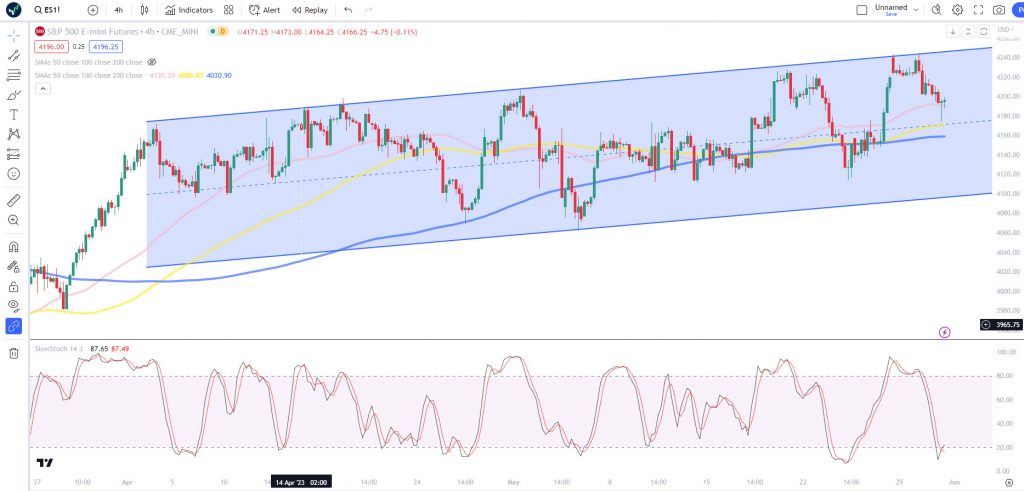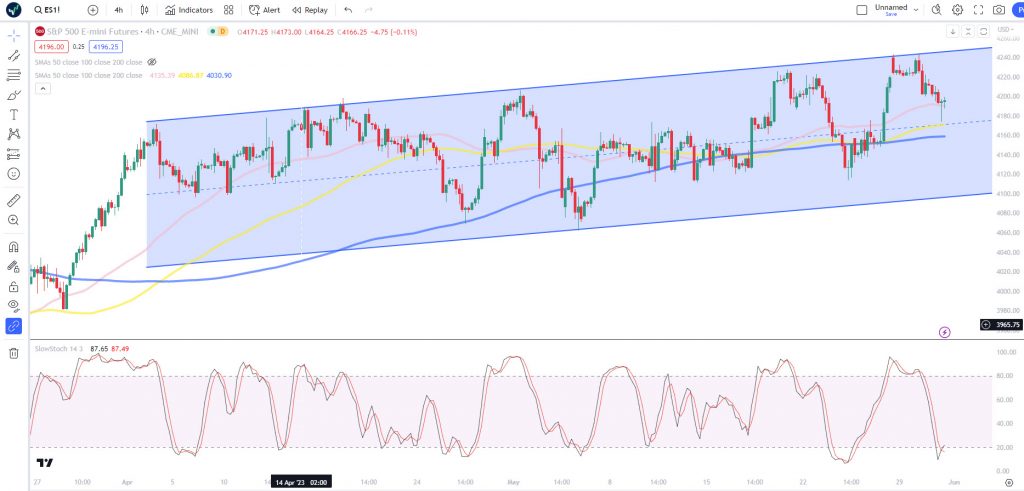Economics
Stocks lower as debt deal and more Fed tightening has economy recession bound
US stocks are falling as the expected debt deal will prove to be negative for the economy as limited spending along with more Fed tightening will send…

US stocks are falling as the expected debt deal will prove to be negative for the economy as limited spending along with more Fed tightening will send the economy to a recession at the end of the year. The US doesn’t look like it will default, but recession worries, possibly stagflation risks, will make life hard for risky assets.
Debt Vote
The divided House will soon vote on the bill, needing a 218-vote majority for it to advance to the Senate. Voting is expected to start at 330pm est and end around 830pm est. The far wings of both parties are expected to show some resistance, but this bill is expected to advance. The Senate might have some difficulty passing the bill but expectations are elevated that the US will avoid defaulting on its debt.
US Data/Fed
JOLTS data reminded Wall Street that this economy has a labor market that doesn’t want to break. Market calls that the Fed is done hiking won’t be able to shake off this labor market strength if Friday’s NFP report confirms this trend. In April, job openings stood at 10.1 million, well above the consensus estimate of 9.4 million, and the upwardly revised prior reading of 9.745 million. Wage pressures will push inflation higher, which should seal the deal for more Fed rate hikes.
Before we saw the hot JOLTS report, Fed’s Mester noted, “I don’t really see a compelling reason to pause – meaning wait until you get more evidence to decide what to do.” So much for the peak being in place, the Fed is going to have to do more tightening and the case for raising at the June 14th meeting continues to grow. Fed swap futures are also pricing in a 66.7% chance of a rate hike next month.
China
China’s PMI report was depressing and strengthened the case for further easing. After this round of data, the PBOC should consider easing a lot sooner. Some of the softness in the data can be attributed to the Labor Day holiday, but overall, many red flags are emerging. Concerns with the property sector remain and probably too much of the rebound stems from travel and dining.
The official government manufacturing PMI reading fell deeper into contraction territory, dropping from 49.2 to 48.8. The service sector softened from 56.4 to 54.5.
China’s recovery has hit a brick wall and the PBOC will start cutting rates next month. The impact might be limited, but they need to send a message here.
Oil
Crude prices went on a mini-roller-coaster ride as the US economy continues to send mixed signals. The Chicago PMI reading was disastrous, while the JOLTs report confirmed the labor market is still strong. Oil is down after disappointing PMI readings from China and on expectations that OPEC+ won’t be delivering more production cuts at this weekend’s meeting.
Gold
A debt deal is not necessarily bad news for gold. In early May, gold was surging as the risk of a US default was rising. Congress appears to be in a position to pass a debt deal that will avoid a catastrophic default, which initially was hurting gold prices. The details behind the proposed piece of legislation includes significantly lower spending, which will be a major blow to the economic outlook and likely trigger a much harder hitting recession.
Another dose of robust labor data is also raising the risk that the Fed will need to do more tightening that will eventually lead to much weaker lending. Unless inflation plays nice over the next few months, the US economy is likely headed towards a recession. The risks of inflation being sticky should be the base case, which means the Fed will raise rates at least once more.
Crypto
Bitcoin’s monthly win streak will come to an end as Wall Street directs their attention on short-dated Treasuries, AI bets, and more traditional safe-haven trades. If Bitcoin were Superman, Fed tightening would be its kryptonite. Today’s Fed speak and hot labor data support the case for more Fed rate hikes and that should keep Bitcoin trapped in the lower boundaries of its trading range.

Argentina Is One of the Most Regulated Countries in the World
In the coming days and weeks, we can expect further, far‐reaching reform proposals that will go through the Argentine congress.
Crypto, Crude, & Crap Stocks Rally As Yield Curve Steepens, Rate-Cut Hopes Soar
Crypto, Crude, & Crap Stocks Rally As Yield Curve Steepens, Rate-Cut Hopes Soar
A weird week of macro data – strong jobless claims but…
Fed Pivot: A Blend of Confidence and Folly
Fed Pivot: Charting a New Course in Economic Strategy Dec 22, 2023 Introduction In the dynamic world of economics, the Federal Reserve, the central bank…
















